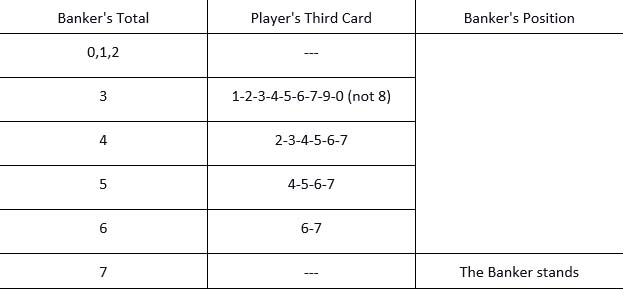Baccarat Card Values
The first step to learn how to play Litecoin Baccarat is to familiarize ourselves with Baccarat card values. Before we start with it, let’s roll our tongue and pronounce ‘bakaʀa’. Yes, the letter ‘t’ is silent in Baccarat.
What’s in a name you asked? Baccarat is the French spelling for the Italian word baccarat, which means “zero” or “nothing,” signifying face cards’ point values. Now you know why Tens, Jacks, Queens, and Kings have zero value in the game. Other cards from 2-9 are counted as their face value and the ace counts as one.
Moreover, the total hand value cannot exceed 9. If the hands value more than 9 they are subtracted by 10. Suppose, a hand is 4 – 9 -5, the total value would be 8 or 18 minus 10. Such a hand with a value of 8 or 9 is called ‘natural’. Also, two 10s is zero.
The next step to our ‘How to Play Baccarat’ guide is mastering Baccarat’s hands. In Baccarat, players make bets on the result of either of the two hands – the Banker’s and the Player’s. Both these hands are made up of 2-3 cards each. A hand that beats another wins the pot. Moreover, you can also bet on a Tie.
Let’s discuss what beats what.
Player’s Hand
The Player’s hand is the first one to be dealt with. Two cards are dealt with each side, which is then turned over by the dealer. In some situations, if the value is between zero and five, a third card is dealt. The winning card is the one that totals the nearest to 9. If the total is between six and nine, no cards are dealt with because the Player stands, meaning, no cards are dealt with further. The Player hand pays in a 1:1 ratio and the house edge is 1.24 %. Learning how to play Baccarat becomes more exciting when you know your winnings on a Player hand is usually two times of your bet. Mouthwatering, isn’t it?
Here’s how a Player hand wins –
- A natural hand (eight or nine) wins against any Banker hands except eight or nine.
- If the player hand has a value of 8 against a Banker’s hand totals 9, the Banker wins and vice versa.
Banker’s Hand
The Banker’s hand is dealt second with two cards face up. Additional cards are not drawn if the hand totals 7, 8, or 9. However, things get a little complicated as to when a banker draws an additional card.
The Banker stays on a total of 6-7 and draws an additional card on a score of 0-5 given that the Player’s hand does not need a third card. If this isn’t the case, the banker draws an additional card.
How to play Baccarat becomes a daunting question if you are to memorize all the scenarios where the banker draws a third card. Fortunately, you don’t need to memorize many such scenarios as the dealer does all the hitting. Moreover, you can also download our resourceful tool – ‘Baccarat drawing guide’.
It is often said that you should always bet on the Banker. Experts believe that the Banker’s hand has more than 50% odds of winning as it is dealt second.
Banker’s hand has a house edge of 1.06%, which is lower than the Player’s hand. Meaning, if your bet on the Banker wins it pays you around 95% of your wager. The Banker pays 1:1 while there is a 5% commission on Banker bets.
Rules for Drawing Additional Cards
One of the trickiest parts of how to play Baccarat is the additional card drawing rules. As discussed earlier, the game may require drawing additional cards to the Banker’s or Player’s side. The third card is drawn based on certain rules, which only seem to verify the fact that Baccarat is a simple yet sophisticated game. Don’t worry this article has got your back.
The rule of thumb is that if either the Player or the Banker’s hand totals 8 or 9 they both stand, no additional card would be pulled.
Otherwise –
- The Player stands if it totals 6 or 7.
- The Banker hits on a total of 5 or less if the Player stands.
- The Player automatically hits if the hand totals 5 or less and in this case, the Banker gives the Player an additional card.
If the Player has pulled the third card, the Banker is also permitted to draw an additional card given it follows certain rules. To be more precise, the instances when the Banker can draw a third card depends on the Banker’s total and the Player’s third card.
Here’s when the Banker draws an additional card.
After reading this table you would ask – Why is drawing an additional card this complicated? Well, this is how Baccarat is played. Another potential answer would be – To keep Baccarat as unique as it is. Because if the win was determined by the first two cards, then Baccarat would be nothing else than a new version of Hi-lo.
Pattern Spotting
If you ever ask how to play Baccarat to pattern believing gamblers they would say – “Get the pattern right and the prize is yours.” Nevertheless, the fact is that the sequence of results in past hands won’t give you any clue of the next outcome.
Still, some gamblers keep a track of how many Player, Banker, and Tie hands have passed. For this, they use scoreboards. This practice of tracing previous results anticipating a clue is called pattern spotting. The casinos are well aware that this won’t bear fruit and thus they entertain this false belief. Land-based casinos offer a sheet and pencil, while online gambling sites display previous results in a grid format.
Honestly, pattern spotting isn’t a winning strategy as previous results do not govern the next hand. However as promised in the beginning, no matter what’s your version of ‘How to play Baccarat’, this article has you covered.
So, here’s a list of some popular patterns –
1. Bead Plate
This pattern has several names including – cube road, dice road, marker road, bead plate road, and even baby pig road. In this pattern Player, Banker, and Tie wins are marked with different colors to keep a record of the wins.
- Blue – Player win
- Red – Banker win
- Green – Tie win
Players start tracing from the upper left corner to the bottom row. This continues over one column to the right, back to the top row.
2. Big Road
In the ‘Big Road’ pattern, the sequence of Player and Banker wins are recorded in a six-row structure. If there are more than six consecutive wins, the scoring moves towards the right. This pattern creates a ‘dragon tail’. The Big Road is the parent road from which other roads are derived.
The color scheme of this pattern is –
- Blue – Player win
- Red – Banker win
- Green – Tie win
Player pairs are marked in the lower right corner while Banker pairs are recorded in the upper left corner. Tracing this pattern starts at the upper left and a new column is started every time there’s a change in Player and Banker winning.
3. Big Eye Boy
The ‘Big Eye Boy’ keeps the records of the repetition of the shoe, the Random Number Generators that mimic the ‘shuffling’ of the deck.
Here’s how the repetition is recorded using colors
- Red – Repetition
- Blue – Chaotic
Once the first entry in the second column of the ‘Big Road table’ is marked, the ‘Big Eye Boy’ table starts recording its entry. The Big Road table and the Big Boy table are correlated and thus, every entry in one of these tables will mark a specific entry in the other. If your head is spinning while tracing the sequence, glance at the last entry of the Big Road and then move one cell to the left and then up. If it is a change, mark blue; otherwise, mark red. Simple isn’t it?
4. Small Road
The Small Road pattern is similar to using the Big Eye Boy. However, the column to the left of the current column in the Big Road is skipped. While recording in Small Road, the players wait until the first entry in the third column of the Big Road is marked.
The depth of the Big Road columns is compared to the Small Road columns by using circles. Red circles represent that the first and third columns to the left of the new column in Big Road are of the same depth. On the contrary, blue circles indicate the columns have distinct depth.
You have to move in the Small Road pattern after considering the newest entry in the Big Road. Move two cells to the left and then up. If you record a change mark blue if not mark red.
5. Cockroach Pig
This pattern skips two columns to the left of the current column in the Big Road. Cockroach Pig is very similar to the Small Road pattern. The Cockroach Pig waits until the first entry in the fourth column of the Big Road. In this pattern, the first and fourth columns to the left of the new column in the Big Road are compared. Similar to the Small Road, a red circle will mean they are of the same in-depth, while a blue circle will indicate they have varying depths. Marking entries in this pattern is the same as the Small Road pattern.
Is It Worth Using Pattern Spotting?
How important it is to learn pattern tracing while learning how to play baccarat? Well, the pattern spotting charts are nothing else than a superstition. These charts do not decrease the house edge nor do they give you an edge over other players. However, if the arduous of tracing patterns induce confidence in you then it might be worth your effort. But remember, this is merely a belief. Also, if you are inclined towards Macau Baccarat tradition you can take this approach. Nevertheless, squeezing or blowing on cards to banish bad luck is childish; so is pattern spotting.
In a Nutshell
Now that you have reached here, let’s put all the pieces together and answer – How to play Baccarat?
Baccarat is an exciting card game where players bet on one of the three outcomes – Banker win, Player win, or a tie. The Banker as well as the Player’s hand is made up of two-three cards. The hand which is closest to nine is the winner. Many gamblers trace patterns to cement their win. However, such practices have no significance in Baccarat. Nevertheless, there isn’t a surefire strategy to win this game.
So, how to play Baccarat?
Watch the odds, know the rules, risk what you lose, and place your bets. That’s it!







